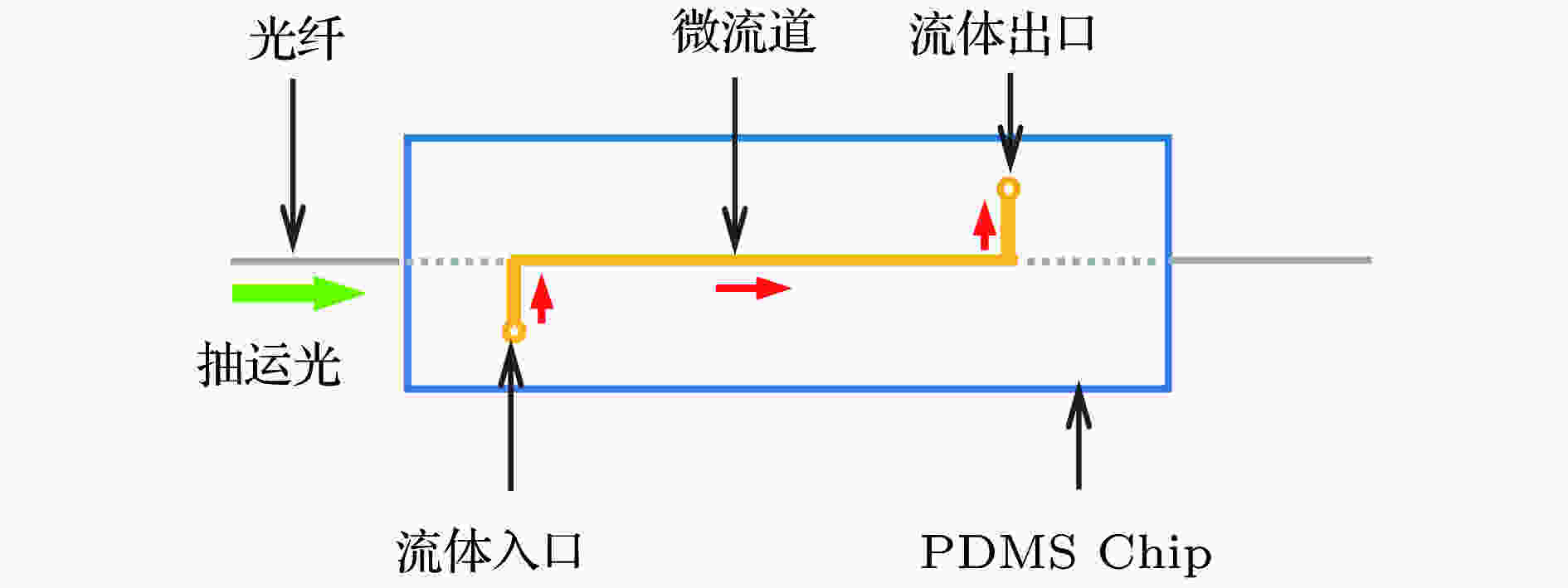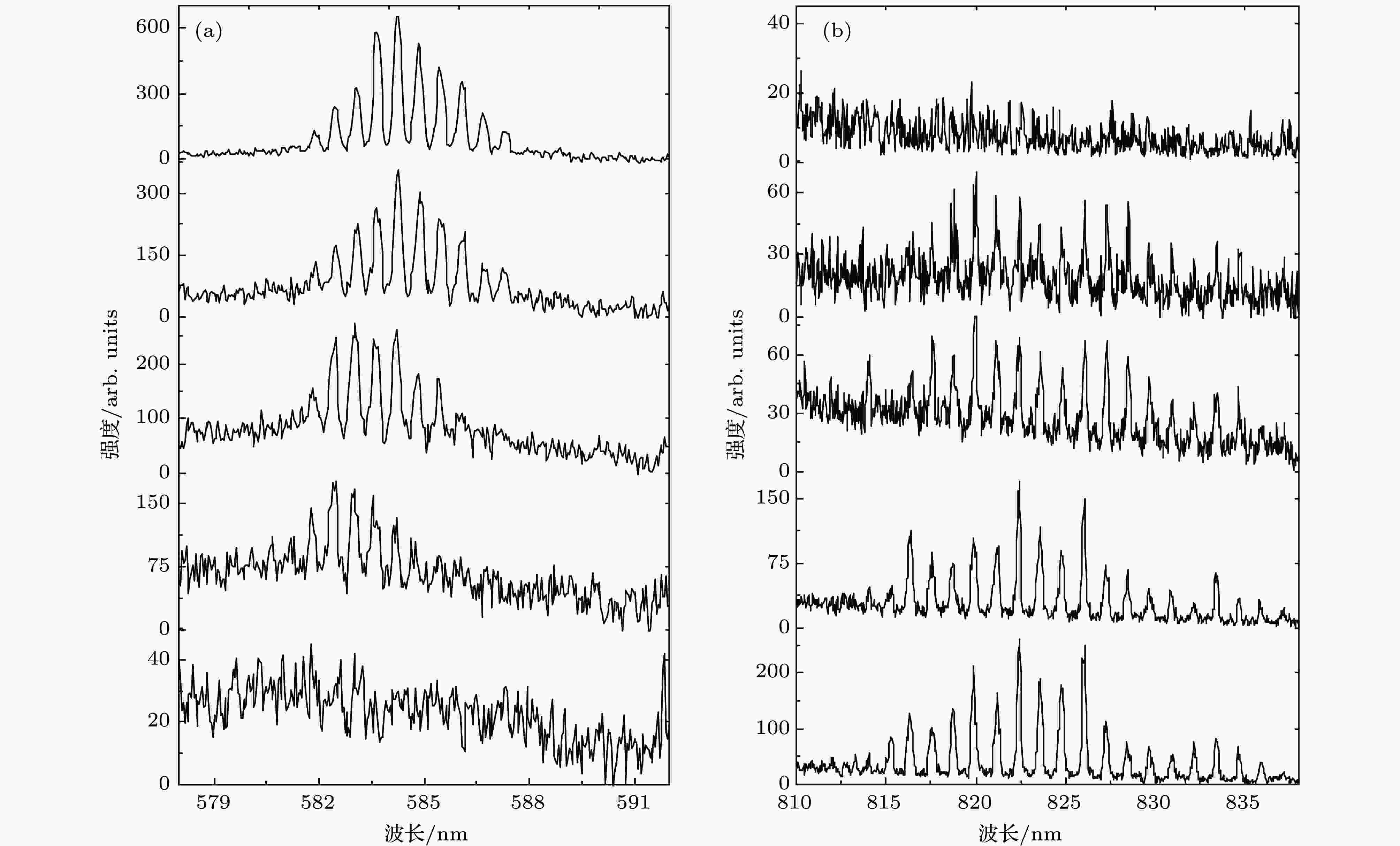全文HTML
--> --> -->1992年, Armstrong等[13]首次观察到了悬浮于F548 (激光辐射范围: 559—589 nm)乙醇溶液中的荧光溶胶小液滴在609—654 nm范围的激光辐射. Maslov[14]以LD1作为能量供体, LD703作为能量受体, 实现了从黄光到近红外光的可调谐激光辐射. Fan研究组[15]利用FRET效应, 在光流控环形谐振腔(optofluidic ring resonator, OFRR)中实现了以罗丹明6G染料作为能量供体, LDS722染料作为能量受体在黄光到近红外波长范围的激光辐射. Sun等[16]利用标记DNA分子和染料分子间的FRET效应, 在OFRR中探测到了微摩尔浓度量级的DNA分子的激光振荡. 虽然FRET在波长可调谐的激光辐射以及保持较低受体激光阈值方面取得了较大进展, 但其采用的垂直于毛细管轴向的侧向光抽运方式仍存在如下三个突出不足: 1)抽运光直接穿过OFRR系统中的样品, 这种强光的长时间照射易造成染料分子的漂白, 从而影响激光器的稳定性; 2)侧向光抽运属于一种非均匀抽运, 染料分子对抽运光有强烈吸收作用, 其较大的吸收使得侧向抽运光在OFRR内的空间分布是非均匀的, 由此产生的激光也是非均匀的, 此外染料分子的增益由抽运光直接激励产生, 不利于抽运光和信号光的分离; 以上两方面的不足都会引起较强的背景噪声, 从而降低探测的信噪比; 3)FRET能量转移效率与供受体分子的间距(供受体浓度比)密切相关, 需要手动更换OFRR系统中的样品溶液才能获得FRET能量转移效率, 极大地影响系统的稳定性.
为了解决以上不足, 本文设计并制作了一种基于聚二甲基硅氧烷(polydimethylsiloxane, PDMS, 折射率1.410)的微流芯片. 首先将单一折射率的石英裸光纤(折射率1.458)植入PDMS基片微流道中, 然后在微流道中注入低折射率的染料溶液作为激光增益介质. 采用沿光纤轴向光抽运方式, 进入光纤端面的抽运光以全反射(total internal reflection, TIR)方式沿光纤轴向传播, 其消逝场延伸到包层溶液中, 并在此消逝场区域内激励染料分子形成激光增益. 垂直于石英光纤轴向的任一截面都构成一个OFRR, 此圆形微腔中回音壁模式(whispering gallery mode, WGM)的消逝场和抽运光的消逝场在增益区域内高度重合, 受激辐射光在微腔WGM 的支持下形成激光振荡[17]. 由于WGM激光增益由抽运光的消逝场激励产生, 从而实现了抽运光和信号光的分离; 而且, 由于抽运光的消逝场在光纤周围是均匀的, 因此, WGM激光辐射在光纤周围也是均匀的. 所以, 采用沿光纤轴向消逝波激励方式, 能够有效地降低背景噪声的影响, 从而提高探测的信噪比和灵敏度. 同时, PDMS微流芯片上的流体入口和出口分别与微型蠕动泵相连接, 从而实现了微流道中溶液的循环流动以及自动更换, 解决了染料溶液易漂白以及由于手动更换溶液而导致系统的稳定性降低的问题. 在此基础上, 以低折射率的罗丹明B (RhB)和吡啶821 (LDS821)的乙醇混合溶液构成的供体和受体对作为激光增益介质. 采用沿光纤轴向消逝波光激励方式, 首先以波长为532 nm的连续波(continue wave, CW)激光器作为激励光, 对FRET特性参数进行了研究; 在此基础上, 以波长为532 nm的脉冲激光器作为抽运光, 在不改变抽运光波长的条件下, 利用染料分子间的FRET机制, 实现了较低阈值的受体LDS821激光辐射.
2.1.PDMS芯片的设计与制作
如图1所示, PDMS基片采用铸模法制作而成, 其尺寸为34 mm × 15 mm (长 × 宽). PDMS基片中光纤通道的尺寸为34 mm × 0.2 mm × 0.2 mm (长 × 宽 × 高), 尺寸为20 mm × 0.3 mm × 0.3 mm的微流道包含于光纤通道中. 基片由苏州汶颢微流控有限公司生产制作. 图 1 PDMS芯片结构示意图
图 1 PDMS芯片结构示意图Figure1. Structure diagram of the PDMS chip.
为方便微流道中液体的循环流动, 需对微流道外的光纤通道与光纤的缝隙处进行封堵, 如图1虚线所示. 封堵过程如下: 首先, 一段长度约为50 mm的光纤(直径约为190

2
2.2.实验装置
实验装置如图2所示, 以波长为532 nm的YAG激光器(北京镭宝公司生产, 脉宽为7 ns)作为抽运光. 抽运光依次经过分束镜BS, 以便由激光能量计PM (MELLES GRIOT, 13PEM001)测出即时抽运能量. 然后经过由透镜L1和L2构成的光学缩束系统后再经一块焦距为75 mm的透镜L3汇聚于光纤前端面, 焦点距石英光纤前端面约为2 mm, 抽运光在光纤内沿光纤轴向以TIR方式传播, 其消逝场(Ep)渗透到包层溶液中, 并在此消逝场区域内激励染料分子产生激光辐射, WGM激光沿光纤表面切向辐射出来, 由导光光纤送至光谱采集系统(ICCD: PI-MAX; spectrometer: Spectrapro 500i)的进光狭缝口. 增益介质溶液经微型蠕动泵BT100-2J上的导管与PDMS上的流体入口和出口相连, 其流速为1.0 mL/min. 图 2 实验装置图 BS, 分束镜; PM, 激光能量计; L1, L2, L3表示透镜; 插图为激光产生的原理图, Ep表示 抽运光的消逝场, Ew表示WGM的消逝场
图 2 实验装置图 BS, 分束镜; PM, 激光能量计; L1, L2, L3表示透镜; 插图为激光产生的原理图, Ep表示 抽运光的消逝场, Ew表示WGM的消逝场Figure2. Illustration of the experimental setup. BS, beam splite; PM, power meter; L1, L2, L3, lens. Inset: the schematic diagram of laser: Ep, evanescent field of pump light; Ew, evanescent field of WGM.
3.1.FRET能量供体浓度的选取
实验中选用RhB和LDS821分别作为FRET的能量供体和能量受体. 首先测量了不同浓度的RhB (0.05, 0.10, 0.30, 0.50, 0.70, 1.00 mM, 1 M = 1 mol/L)的激光阈值. 如图3所示, 随着RhB浓度增加, 激光阈值呈现出先减小后增加的趋势, 当c = 0.5 mM时, 激光阈值达到最低. 因此, 为了实现低供体阈值、低供体浓度条件下高效率的基于FRET机制的激光辐射, 本文中我们选用c = 0.5 mM的RhB作为能量供体. 图 3 不同RhB浓度对应的激光阈值, 误差线是三次测量的平均值
图 3 不同RhB浓度对应的激光阈值, 误差线是三次测量的平均值Figure3. Lasing threshold of RhB as a function of the dye concentration. Error bars are obtained with three measurements.
2
3.2.FRET特性参数实验
图4是浓度均为0.5 mM的RhB和LDS821 的乙醇溶液(折射率1.361)的吸收和辐射光谱. 由图可知, RhB和LDS821在542 nm和590 nm处具有它们各自的吸收峰, 在580 nm和800 nm处具有各自的辐射峰; 同时, RhB的辐射光谱和LDS821的吸收光谱为FRET提供了良好的光谱重叠[18], 且选用532 nm的绿色抽运光非常有利于激发供体RhB. 图 4 归一化吸收和辐射光谱 蓝色和紫色实线分别表示RhB和LDS821的吸收光谱; 绿色和红色实线分别表示RhB和LDS821的辐射光谱
图 4 归一化吸收和辐射光谱 蓝色和紫色实线分别表示RhB和LDS821的吸收光谱; 绿色和红色实线分别表示RhB和LDS821的辐射光谱Figure4. Normalized absorption (blue, RhB; purple, LDS821) and emission (green, RhB; red, LDS821) spectra.
为了系统地表征能量转移效率及测定供受体对之间的F?rster距离(R0)等FRET特性参数, 我们用微泵BT100-2J将RhB和LDS821的乙醇混合溶液通入PDMS芯片的微流道中, 以波长为532 nm的低功率(5 mW) CW 激光器作为激励光, 获得如图5(a)所示的供-受体 (A/D) 对荧光辐射光谱. 如图中蓝色实线所示, 在没有供体RhB时, 由于激励光远离受体LDS821(浓度c = 1.0 mM)的吸收峰且自身的荧光量子效率较低[19], 导致LDS821对激励光的吸收较弱, 从而使得LDS821荧光辐射强度也较弱. 相反, 在没有受体LDS821的情况下, 由于没有发生FRET, 供体RhB (c = 0.5 mM)对激励光有较强的吸收且自身的荧光量子效率较高[19], 所以在













 图 5 (a) 以RhB和LDS821分别作为能量供体和能量受体的归一化荧光辐射光谱, A/D为受体与供体浓度比值, 图中“A/D = 1.0/0 mM”表示没有供体时受体的辐射光谱, 其他值表示固定供体浓度为0.5 mM, 不同受体浓度所对应的FRET光谱, 插图为微流道中荧光辐射的实物图; (b)红色三角形是根据图5(a)计算得到的能量转移效率
图 5 (a) 以RhB和LDS821分别作为能量供体和能量受体的归一化荧光辐射光谱, A/D为受体与供体浓度比值, 图中“A/D = 1.0/0 mM”表示没有供体时受体的辐射光谱, 其他值表示固定供体浓度为0.5 mM, 不同受体浓度所对应的FRET光谱, 插图为微流道中荧光辐射的实物图; (b)红色三角形是根据图5(a)计算得到的能量转移效率
Figure5. (a) Normalized fluorescence spectra of RhB (donor) and LDS821 (acceptor); A/D, acceptor to donor ratio, A/D = 1.0/0 mM was collected for 1.0 mM acceptor in the absence of donor and the other spectra were collected for a constant donor concentration of 0.5 mM and the acceptor concentration changing from 0 to 8 mM; inset, the picture of fluorescent radiation generated in the PDMS microfluidic channel; (b) the red triangle is the experimental value of the energy transfer efficiency

2
3.3.理论解释
当供体分子(RhB)吸收抽运光的能量后被激发到更高的电子能态, 在该电子回到基态前, 通过偶极子间的相互作用将其能量以非辐射方式传递给其邻近的受体分子(LDS821). 由图5(a)可知, FRET的直观表现就是, 当存在受体时, 供体的荧光辐射强度较其单独存在时要低得多, 而受体荧光辐射强度却大大增强.不同比例的供受体对间的能量转移效率








2
3.4.FRET激光实验及讨论
通过表征FRET特性参数以后, 我们利用RhB和LDS821分别作为能量供体和能量受体的FRET激光实验. 实验中, 以波长为532 nm的YAG脉冲激光器作为抽运光, PDMS基片微流道中流体的流速仍为1.0 mL/min. 保持抽运光的能量密度不变(约为1.45

 图 6 (a)不同A/D值对应的低等分辨率(光栅密度g = 150 g/mm)的FRET激光光谱, 供体浓度保持0.5 mM不变; (b)激光辐射峰强度随抽运光能量密度的变化关系; 供体峰值为585 nm, 阈值约为0.48
图 6 (a)不同A/D值对应的低等分辨率(光栅密度g = 150 g/mm)的FRET激光光谱, 供体浓度保持0.5 mM不变; (b)激光辐射峰强度随抽运光能量密度的变化关系; 供体峰值为585 nm, 阈值约为0.48 








Figure6. (a) Low resolution (grating density = 150 g/mm) FRET lasing spectra for various A/D values, the donor concentration is fixed at 0.5 mM; (b) lasing peak intensity vs. pump energy density. The donor peak is at 585 nm and its lasing threshold is approximately 0.48









 图 7 不同A/D值对应的中等分辨率(光栅密度g = 1200 g/mm)的激光光谱 光谱图从上到下分别对应A/D = 0/0.5, 0.5/0.5, 1/0.5, 4/0.5, 8/0.5 mM; (a) RhB(供体)的激光光谱; (b) LDS821(受体)的激光光谱
图 7 不同A/D值对应的中等分辨率(光栅密度g = 1200 g/mm)的激光光谱 光谱图从上到下分别对应A/D = 0/0.5, 0.5/0.5, 1/0.5, 4/0.5, 8/0.5 mM; (a) RhB(供体)的激光光谱; (b) LDS821(受体)的激光光谱Figure7. Medium resolution (grating density = 1200 g/mm) lasing spectra for various A/D values. The spectra correspond to A/D = 0/0.5, 0.5/0.5, 1/0.5, 4/0.5, 8/0.5 mM from top to bottom: (a) Lasing spectra of RhB (donor); (b) lasing spectra of LDS821 (acceptor).
图6(b)是在没有受体时RhB (c = 0.5 mM)在




























